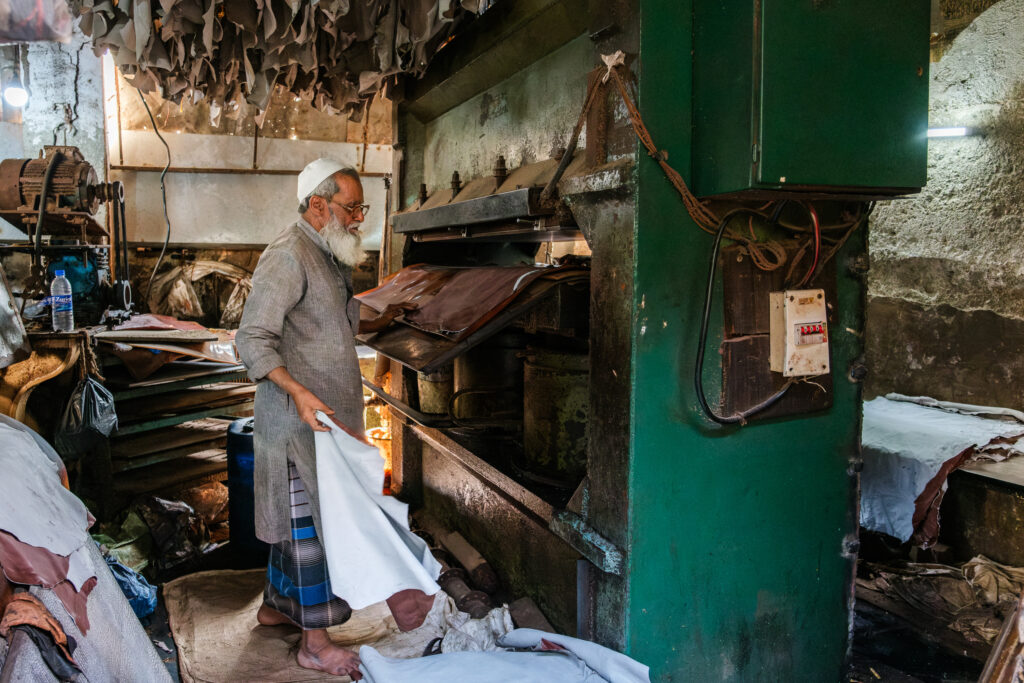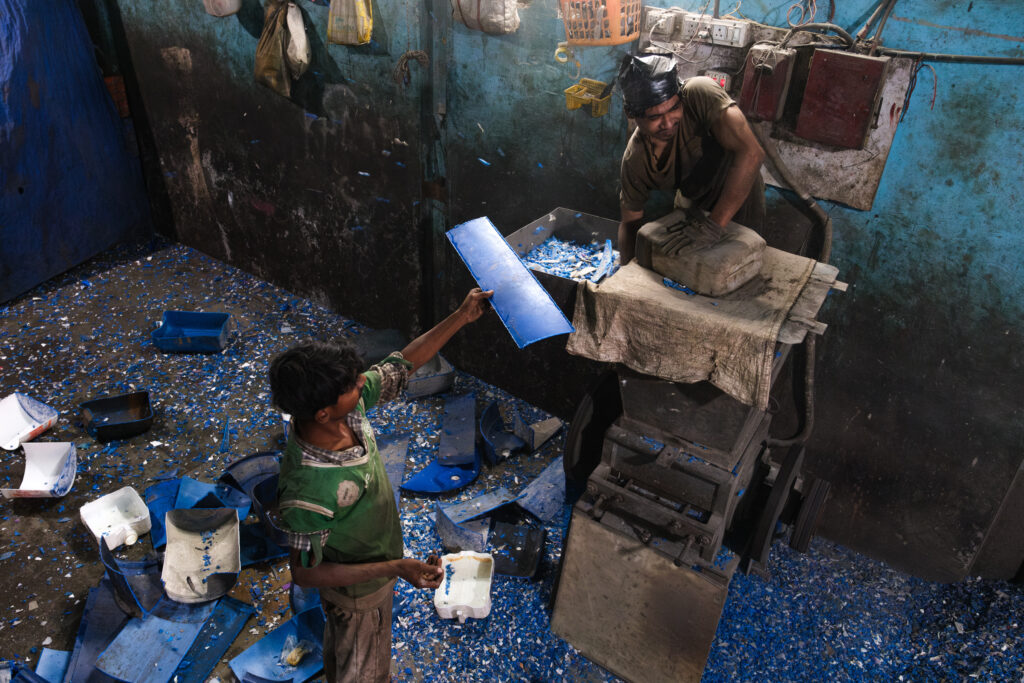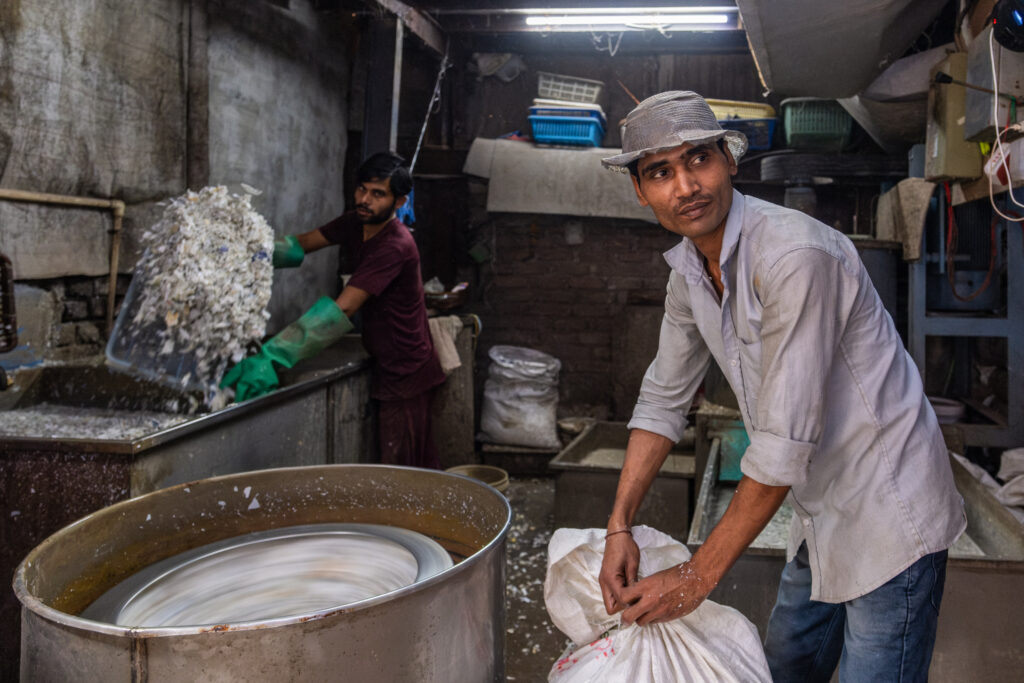“If you heat a piece of plastic and the melted parts stretch out and strings, you know it can probably be recycled,” grins Mobin Sheikh. I am sitting with Mobin in a backroom of his garments showroom on the edge of Dharavi. The showroom sits on a bridge which forms the northern border of Dharavi. To one side lies the haphazard patchwork of hutments that is often referred to (wrongly) as Asia’s largest slum. On the other, the mangroves of the Mithi river across which lies the Bandra Kurla complex, the city’s glittering glass and steel financial hub. Mobin wears many hats, he is the Secretary of the Dharavi Business Persons Association, an advisor to All Plastic Recyclers Association, a businessman with interests in garments and plastics manufacturing and a person with a deep understanding of Dharavi and what makes it tick. I am here to talk to him about the business of recycling in Dharavi, how it all works and what makes it a uniquely efficient ecosystem adept at converting the waste Mumbai discards, to dollars.
Ingenuity & Frugality: Waste to Value in Dharavi
18 March 2024 | Photography by Hoshner Reporter

The characterization of Dharavi as a slum while accurate is hardly representative of everything Dharavi is. While the estimated million odd inhabitants of Dharavi live quite literally cheek to jowl in an area of about 2.4 square kilometers, it is a city within a city with residential areas, commercial areas, schools, temples, mosques, restaurants and everything else you would expect from a thriving community. It is a community that while isolated from a large number of Mumbai’s citizens, is critical to the megapolis and its ability to keep going and growing.

Not only does Dharavi recycle large amounts of Mumbai’s solid waste (published estimates vary between 50-80%, though there are no official numbers), it is also a thriving center of small scale manufacturing. Mobin reckons that the often stated statistic of Dharavi having a turnover of a billion dollars annually is a gross underestimation, he puts the number closer to 3 billion USD with e-commerce companies picking close to an estimated 100,000 parcels for delivery from Dharavi every day! Not something you would expect from a typical ‘slum’. Most of this work happens in the commercial area of Dharavi commonly known as the 13 compounds which gets its name from the original compounds set up here decades ago mainly to process byproducts from textile mills. Today the 13 compounds has thousands of small units, most no larger than 200-300 square feet involved in a myriad of activities from leather and garment making, to luggage manufacturing and food processing.

The 13 Compounds is also where the recycling units of Dharavi are set up. It is important to understand that the recycling industry here has been in operation well before environmental concerns made recycling front and center of discussions around the circular economy. It is a trade evolved over years, through trial and error by those at the margins of society, to seek the greatest possible profit and utility out of items discarded by the rest of society. It does however provide a great ecosystem service to the city of Mumbai, collecting, segregating and processing, free of cost, waste which Mumbai’s Municipal corporation is simply unable (or unwilling) to, and which would otherwise be burned or end up in landfills and oceans. People like Mobin believe that the Dharavi model of recycling – where lived experience and intergenerational transfer of knowledge coupled with ingenuity, frugality and the lower cost of labor- enables not only a wider range of materials to be recycled and repurposed but also allows value to be extracted in ways which would otherwise not be possible.

I am walking through the narrow bylanes of 13 compounds with Raj, a resident of Dharavi, who is showing me around the place. Raj’s family settled here from Goa decades ago and he knows the maze of streets and workshops like few others. There is a buzz of activity around. Trucks are being loaded and unloaded, workers carry huge sacks to and from tiny workshops where they are weighed, bought and sold. There is an incredible assortment of waste everywhere – from old fans to sacks of takeaway containers, bottles and other assorted plastics piled up outside workshops and atop roofs- all of which has found its way here via a complex network of collectors and traders.

Individual waste collectors known as ragpickers operate in local areas and collect waste off the street, beaches, public garbage bins and even from municipal landfills. These ragpickers form the bedrock of the informal waste system. Often walking 15-20 kms, they end up collecting 40 to 50 kgs of waste daily. Plastic or PET bottles are most popular as they are easy to carry and command a good price, but they will also pick up things like discarded alcohol bottles or construction waste like used wires (salvaged for their copper) and iron rods. This waste is then sold ahead to intermediaries called kabadiwalas or katawalas. Kabadiwalas will also work directly with building societies to buy and collect their dry waste which could include everything from old newspapers and magazines, discarded consumer electronics, bottles and cans or e-commerce cardboard packaging. This is then consolidated and sold ahead, eventually reaching Dharavi’s 13 compounds by the truckload from all corners of the city.

Raj takes me into a dimly lit workshop where workers sit around a row of large crates, sifting through piles of assorted plastic. These small sorting workshops are central to the plastic recycling business in Dharavi. Depending on the color or type of plastic or other materials, items are sorted into the various crates. Larger items efficiently get broken down into individual parts. As I watch, an old wall clock is efficiently dismantled by hammer. The plastic exoskeleton is broken up and chucked into one crate, the clock mechanism in another, and the metal hands in a third. The entire process takes less than a minute and experienced waste workers can recognize a wide range of plastics by look-and-feel and know if they can be recycled. Labels of mineral water bottles or yogurt containers for example are removed and discarded as they usually cannot be efficiently recycled but the containers themselves can be.

This kind of labor intensive disaggregation and segregation is key to realizing value from waste. A sack of unsorted plastic may cost Rs 10-15 /- per Kg but once sorted and broken down it can be resold for much more. The more granular the sorting, the greater the value derivable. Once the sorting is completed the waste is put through a grinding machine, which shreds the plastic into smaller shards making it easier to wash. Rajesh, the manager of this small unit, estimates that he recycles upwards of 20 tonnes of such plastic per month. There are hundreds of these sorting workshops in the 13 compounds and Mobin estimates that the compounds recycle 6,000 tons of plastic waste every month.

Plastic once shredded is then washed in drums or huge baths. The washing of plastics is an important step as particular types of plastics float or sink in fresh or salt water and this allows for further segregation and more efficient recycling. The washed plastics are then dried and packed for shipping outside of Dharavi where they will be further processed into plastic pellets, the final step in their recycling journey.

Besides plastics, Raj shows me many other workshops that process a myriad of waste in Dharavi. The cleaning of paint and chemical cans for reuse is a big business, as is the extraction of copper from the internals of discarded household appliances like washing machines and air conditioners. We visited units solely dedicated to shredding used paper which is then compressed and sold in blocks and others which process used glass bottles, which are either cleaned and resold or broken down for melting. Even shredded byproduct from garment manufacturing is not wasted but used to make stuffing for cheap mattresses which cost a fraction of those made with new cotton. No waste is wasted in Dharavi.

All this, however, is set to change. The Maharashtra government awarded a contract for the comprehensive redevelopment of Dharavi, which with its proximity to the Bandra Kurla financial district and its strategic location in central Mumbai is prime real estate, to companies controlled by Gautam Adani, one of India’s richest men. This latest effort at transforming Dharavi has been years in the making and is not without controversy, but most people I spoke with within Dharavi are cautiously optimistic that the plan will finally take off. Residents of Dharavi who fall within the cut off set by the Government will be entitled to new housing as part of the redevelopment (pending a proposed survey, it is unclear as of now just how many of Dharavi’s residents will be eligible) and there is also a proposed tax rebate package and new workshops for the eligible commercial tenements to encourage formalization of Dharavi’s unregulated industry.
Not everyone is happy though. There are worries that if the industry is forced out, the move to far flung areas outside Mumbai and the fragmentation of the symbiotic networks that make Dharavi work, could drive up transport and other costs to unviable levels with dire consequences for businesses, workers, and for the city itself with its ever-growing mountains of waste. The sentiment is echoed by Mobin Sheikh who feels that systems built here over decades will be lost. “Here in Dharavi, there is a highly functioning ecosystem, everything we need from food, housing, transport and skills is available, it will take us years to rebuild elsewhere.”

